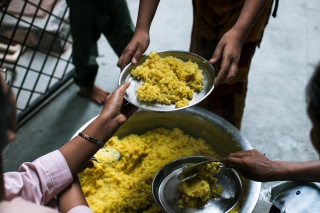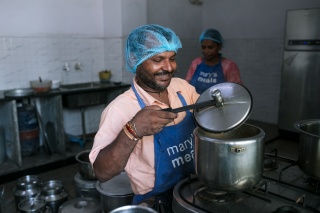
Paving the way to brighter futures in India
The positive impact of our school meals on some of the world's poorest communities
Paige Boxshall, Programme Relationship Manager at Mary’s Meals International, recalls her trip to India and the positive impact our school meals are making in the country.
Since 2004, Mary’s Meals has been transforming young lives in northern India and in the urban slums of some of the country’s largest cities.
Today, through our valued partnership with the Board for Research Education and Development (BREAD), more than 55,000 children across India eat Mary’s Meals every school day, giving them the energy to learn, play and dream.
Paige Boxshall, Programme Relationship Manager at Mary’s Meals International, travelled to India to see this impact for herself. What she encountered was a country of striking contrasts – immense wealth alongside profound poverty – and a powerful truth: a simple daily meal can change the course of a child’s life.

Understanding the impact of Mary’s Meals
Paige says: “I was fortunate to visit our programme in India. It was my first trip to the country and it’s fair to say I carried with me a well-worn set of preconceived ideas shaped by films, stories and second-hand anecdotes. I spent the week with our school feeding delivery partner, Board for Research Education and Development (BREAD).”
“Being with the programme’s staff gives a broader understanding of its moving parts and also strengthens existing bonds and helps to form new ones. And simply being able to focus for several days on that one programme, which is not feasible in my daily work, gives much more opportunity to learn.”

The reality of living in poverty in India
India, the world’s second most populous country, is also home to some of its poorest and most marginalised communities. Nearly one in four people here lives below the International Poverty Line of just $2.15 a day. A stark reminder of the daily struggles faced by millions.
Seeing this first-hand, Paige says: “Nothing could have prepared me for the levels of smog I witnessed. India has some of the worst air-pollution in the world – 30 times higher than the WHO-recommended safe breathing levels the week I was there. Picture barely being able to see your suitcase at the airport baggage carousel, the sun almost blotted out during the day or not being able to see the river you are driving over. Schools and centres were temporarily closed, and people were advised to stay at home because of the hazardous pollution levels. It's not a challenge our other programmes often face, and it hit home that whilst we could rearrange our trip, if necessary, people living there must breathe this air every day and have shorter lives and serious medical conditions as a result.”
Paige continues: “Although it’s a country of great wealth and boasts one of the fastest-growing economies, it’s also one of the most unequal. Millions of children live in multi-dimensional poverty, experience hunger, and face barriers to education. The government operates one of the world’s largest state-run school feeding programmes, but not all schools or places where children receive an education are eligible. This is where Mary’s Meals and BREAD make a difference – ensuring children who would otherwise go without, can benefit from a school meal.”

Supporting children at non-formal education centres
Paige says: “Driving to one centre, we passed private gated mansions on the outskirts of Delhi. However, the wealth soon faded and revealed densely populated communities living a different reality. Tucked behind a bustling urban street was a modest room where a dedicated group of nuns work to support children facing severe poverty, some living in tiny shelters built amongst rubbish dumps with no clean water or electricity. Many families moved [to Delhi] with a dream of better jobs and lives. Sadly, faced with overcrowded environments and limited employment, that often doesn’t materialise. With minimal income from day labouring jobs or collecting and selling metal, it’s difficult to find food for the family and children often forgo education as a result, to help earn extra money. However, with Mary’s Meals, they can go to [these non-formal] centres for a meal and an education, rather than working or scavenging to find food.”
Families taking ownership
Paige says: “We also visited formal primary schools in Jharkhand State. Many of them are in rural locations populated by indigenous, tribal people. Here life was much slower, and the challenges mirrored those of our programmes in sub-Saharan Africa – farmers contending with erratic weather worsened by climate change and children walking miles to and from school.
“Again, there’s limited employment and many rely on subsistence farming for food. Despite this precarity, families donate rice to the school feeding programme where they can. Across all the schools, all those involved with the programme took great pride in it. This was evident in how they spoke about its impact on [their] children, as well as in the well-managed storerooms, clean kitchens, bright menu boards, and well-kept documents.”

A global movement to be proud of
Paige continues: “Pride was something that struck me with all the BREAD staff that I met, too. Spending time with them, after years of remote contact, was my favourite part of the trip. For them, delivering the school feeding programme is a vocation, not a job. Every time they go to a school, they see the impact of Mary’s Meals, and it was an immense privilege to witness that myself and be with the team that is helping to bring our vision to life.”
Paige Boxshall
Programme Relationship Manager, Mary’s Meals International

